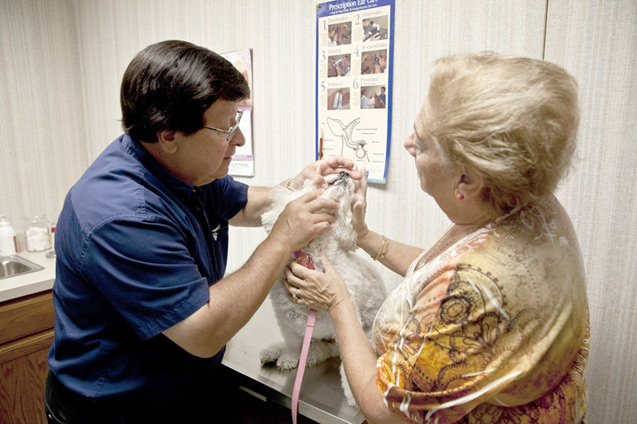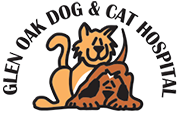
What to Expect if Your Pet Needs Dental Care
Dental procedures are performed daily at Glen Oak Dog and Cat Hospital. How does a loving pet owner know if dental care is needed?
Examination is the key to diagnosis and helps determine the type of treatment needed. You need to know what to look for. A pet owner can help by examining their pet’s teeth and oral cavity at least monthly. First smell your dog or cat’s breath. If you sense a foul odor, gum disease may be present. Periodontal disease is the most common ailment of small animals. Gum problems begin when bacteria accumulates at the gumline around the tooth. Unless brushed away daily, these bacteria can destroy tooth supporting bone, cause bleeding, and if untreated, cause tooth loss. Usually the first sign is halitosis. Other signs you may notice are red swollen gums, tartar (a yellow or brown accumulation on the tooth surface), or loose teeth.
Watch your pet for signs of mouth pain. Have you noticed any changes in chewing or eating habits? A pet with good oral health should have no signs of pain or changes in eating or chewing habits, and minimal or no mouth odor. However, if your pet is experiencing frequent pain or refusing to eat, has changed chewing habits, or has moderate to severe mouth odor, then an oral problem is likely the cause.
When examining your pet’s mouth, look for chips or fractures on the tooth’s surface. Contrary to their popularity, chewing on cow hooves, rocks, bones or other hard materials may break teeth. Many times small pieces of enamel chip off, which usually causes no harm. Deeper chips may cause sensitivity in your pet if they are not treated. If the fracture is deep you may notice a red, brown, or black spot in the middle of the tooth’s surface. The spot is the pulp or root canal, which may which be open inside the mouth, eventually leading to a tooth abscess.
When your home exam reveals dental problems or if you are still uncertain, a trip to the Glen Oak Dog and Cat Hospital is in order. The veterinary oral examination will begin with a complete visual examination of the face, mouth and each tooth. Frequently pet’s mouths have several different problems that need care. The veterinarian will usually use a record chart similar to the one used by human dentists to identify and document such dental problems.
A more detailed exam then follows. Unfortunately cats and dogs cannot point to dental abnormalities with their paws so in order to determine the proper treatment plan, other tests are usually necessary. Sedation and anesthesia are essential for an adequate evaluation. Anesthesia allows the veterinarian or assistant to thoroughly examine each tooth individually. Modern veterinary medicine offers a wide array of safe and effective anesthetics and monitoring equipment that allay previous concerns of anesthesia.
X-rays of abnormal dental conditions can be taken. X-rays show the inside of the tooth and the root that lies below the gumline..
Dogs and cats do not have to suffer the pain and discomfort of untreated broken or loose teeth or infected gums. With the help of thorough examinations, x-rays, dental care, and daily brushing, your pet can keep its teeth in its mouth where they should be.
